All animals (including humans) need a nutritional diet to remain healthy throughout their lives. A nutritious diet provides everything the body needs to grow, heal, and function optimally throughout its life cycle and development stages. A dog can survive years without a fully nutritious diet, but that lack of nutrition will eventually lead to illness as they age. Good nutrition is essential throughout their life.
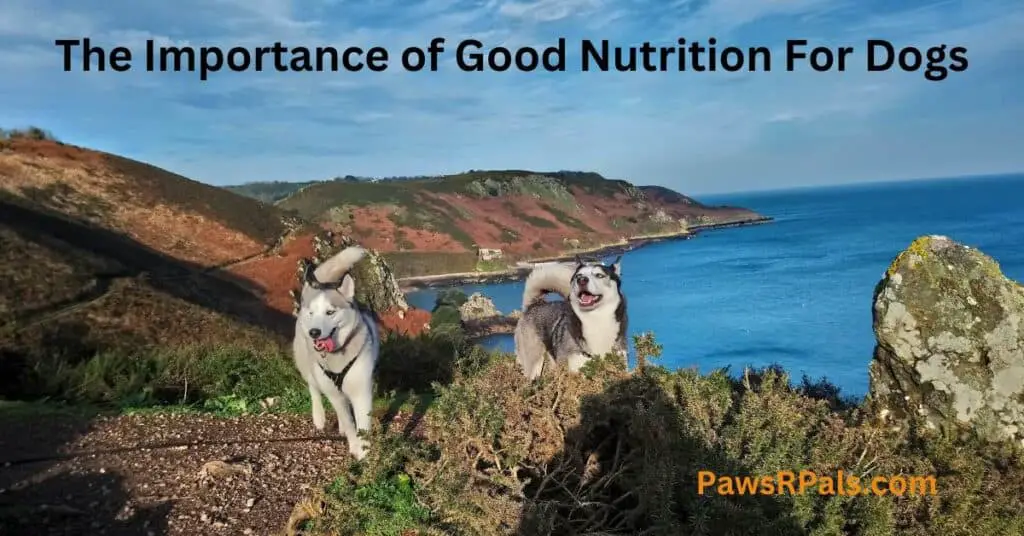
A dog needs a balanced diet to grow and maintain a healthy life. A balanced diet ensures that the dog takes in what it needs to grow, repair, and run its bodily functions to stay healthy throughout life. A poor diet can lead to a dog:
- Being overweight
- Being underweight
- Being malnourished
- Having immune system issues
- Having behavioral issues
- Developing diabetes
- Developing heart problems
- Developing arthritis
- Becoming depressed
Read on to learn more about how a dog’s diet can impact its life, what it needs to flourish, and what you can do to improve it (it doesn’t always have to cost a small fortune!).
How The Dogs Diet Impacts The Immune System
The dog’s diet significantly impacts its immune system, and any issues without an apparent cause should beg the question about what the dog is eating.
The Dogs Digestive Process
- The dog’s strong jaw and large mouth area allow them to eat bones and large chunks of meat easily.
- The dog’s long esophagus and saliva help break down the food in the digestive process. Pieces of food too large to break down by the hydrochloric acid in the stomach can be regurgitated to allow the dog to further re-chew the larger chunks, making them smaller to digest.
- Once the digested food is in liquid form, it can pass into the small intestine for nutrient absorption – the body takes the nutrients it needs, and the rest of the waste goes through the large intestine to the bowl and leaves as feces.
- Liver function (hepatic function) regulates chemicals in the bloodstream and breaks down components, allowing the body to utilize them effectively.
- Oxygenated blood flows through the hepatic artery, and nutrient-rich blood flows through the hepatic portal vein into the liver.
- The liver then breaks down the nutrients, fats, and chemicals to make them useful. The liver also creates bile and/or blood and removes harmful and unnecessary chemicals during the digestive process via feces (bile) or urine (blood chemicals). The liver also produces proteins that are necessary for blood plasma, cholesterol, and hemoglobin (iron storage).
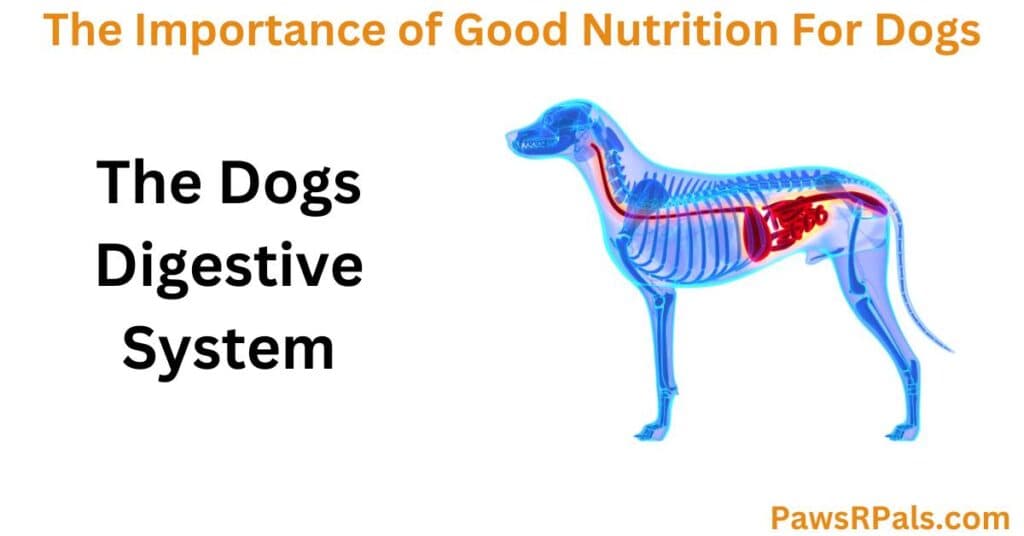
Stress, parasites, illness, and poor-quality food (and food allergies) can all impact the digestive system, which can cause vomiting, loose/runny feces, and general poor health (viral or bacterial).
Stress releases adrenaline and cortisol into the dog’s system – a side effect is that the digestive system shuts down to divert the body’s energy to the ‘flight or fight’ survival instinct.
Parasites, such as worms (hookworms, whipworms, and roundworms – the most common internal parasites), take the nutrients from the food before the dog can digest them. If the dog receives no nutrients from the food, its digestive system can’t function properly, and nutrients won’t be sent where needed to keep the dog healthy.
Poor-quality food will not provide enough nutrients for the dog to function well over a period of time. Likewise, food allergies ingested daily will have a long-term impact as the dog’s immune system has to fight daily to keep the dog healthy – the immune system will eventually become tired and function less and less, leaving the dog prone to illness and infections. Cells that don’t receive enough nutrients cannot repair themselves or reproduce.
The autonomic nervous system (ANS and parasympathetic area) is responsible for everyday functions like heart rate, respiration, organ function, immunity, and digestion – a lack of nutrition will also affect the ANS and the processes it controls.
The Dogs Immune System
A dog’s immunity has two levels: skin and saliva; unbroken skin and a healthy digestive system prevent viruses and bacteria from reaching the internal organs.
The second level of immunity comes from the stem cells in the dog’s bone marrow. Viruses or bacteria that reach this level activate the white blood stem cells (leukocytes) carried around the system faster when the dog has a fever or high temperature.
These cells attack the virus or bacteria to help protect the dog, and the higher body temperature makes the viral/bacterial infection challenging to survive.
Common issues that can affect a dog’s immune system are:
- Genetically inherited illness (unavoidable)
- Environmental stressors (can be worked on)
- Poor diet (can be improved)
- Food allergens (change in diet)
- Environmental allergens (medication)
- Drugs and over-vaccination (can be investigated)
- Illness causing dysfunction
Allergies and Sensitivity
Allergies in dogs are becoming quite common – especially wheat/gluten allergies – much like in humans. Unfortunately, wheat was used as a standard cheap filler in dog food until relatively recently (rice is on the rise in commercial dog food) – wheat is not a natural food source for dogs. Wheat issues are split between wheat allergy and gluten sensitivity; both can have similar symptoms.
Wheat allergy can cause:
- bone and joint discomfort
- pain
- muscle cramps
- breathing issues
- behavioral changes
- dry skin
- itching (skin, eyes, ears, mouth, throat, paws)
- ear issues (recurring ear infections)
- nasal congestion
- epilepsy
- loose/runny bowels
- rash
- swollen skin
- swelling
- poor coat condition
- dandruff
- vomiting
- weight loss
Other allergies can be caused by pesticides, added flavors, or coloring – all unnecessary and can negatively impact a dog’s immune system, leading to illness/disease.
Thyroid Issues In Dogs
The thyroid gland on either side of the larynx in the throat area releases hormones (T3 and T4) to control metabolism. A tug on a collar can easily damage the thyroid gland, so a Y-shaped harness is best for walking a dog. Thyroid issues can not only change a dog’s appearance but also severely impact a dog’s health and behavior.
Hyperthyroidism (when too much hormone is released from the thyroid) can cause a dog to:
- lose weight
- anxiety
- compulsiveness
- depression
- disorientation
- erratic temperament
- fearfulness and phobias
- irritability
- moodiness
- passivity
- periods of hyperactivity
- hypo attentiveness
- submissiveness
- stress
- sudden onset of seizure disorder in adulthood
- unprovoked aggression towards other animals and/or people
Hyperthyroidism has an extensive impact not only on the dog’s health but its behavior too, as the metabolism is sped up, increasing the body and mind’s functions – this can be a lot for a dog to deal with!
Hypothyroidism is when the thyroid doesn’t release enough hormones for the body to function correctly. This can result in:
- cold intolerance
- exercise intolerance
- facial paralysis
- fearfulness
- head tilt
- inattentiveness
- incontinence
- knuckling or dragging feet
- lethargy
- mental dullness
- mood swings
- muscle wasting
- stiffness
- weakness
- weight gain
Hypothyroidism slows down the metabolism, giving the cells less energy and oxygen to function correctly. Jean Dodds, a veterinarian who has researched the thyroid, has said that thyroid problems cause poor health in dogs and are also linked to aggressive behavior in many dogs.
Thyroid dysfunction can also affect a dog’s behavior dramatically – external symptoms such as poor skin and coat, itching, and allergies can often be treated (these can be precursor signs of thyroid dysfunction); however, the underlying problem of the thyroid often goes unmissed, which can lead to aggression in the dog – Jean Dodds study has proven that undiagnosed hypothyroidism often leads to aggression.
The dog’s body is flooded with higher cortisol levels (mimicking the body’s natural stress reaction), which means the dog is often in a heightened state of flight or fight mode and is simply unable to function rationally.
Poisoning in Dogs
Organophosphate ingestion (the veterinary term for long or short-term poisoning) can seriously damage a dog’s health. Unfortunately, many chemicals, such as pesticides, herbicides, and nerve gases, are found in homes and industry.
Many flea and parasite topical treatments contain a form of insecticide, which should never be given to a sick dog or a dog with a lowered immunity.
Some symptoms of organophosphate ingestion include:
- anorexia
- breathing difficulties
- constricted pupils
- depression
- diarrhea
- vomiting
- drooling
- excessive urination
- muscle weakness
- seizures
- death
There is a growing concern about the excessive use of pesticides on human-grade food and the problems that this can cause.
Dogs with Hypertension and Hypotension
Hypertension (high blood pressure) and hypotension (low blood pressure) can be caused by lifestyle, environmental factors, illness, or genetic inheritance, like in humans.
Hypertension can be caused by:
- high sodium diet
- adrenal diseases
- tumours
- artery obstruction – cholesterol
- Cushing’s disease
- endocrine system diseases
- heart condition
- body injuries
- kidney problems/kidney damage
- nervous system problems
- obesity
Symptoms can include:
- bleeding from the nose
- blindness
- blood in the urine
- depression
- dilated pupils
- disorientation
- heart murmurs
- haemorrhage of the eye
- hiding behavior
- hyperactivity
- involuntary oscillation (rolling) of the eyeballs
- palpable thyroid gland (when hyperthyroid)
- protein in the urine
- retinal detachment
- seizures
- swollen or shrunken kidneys
- weakness, either on one side of the body or in the legs
Hypotension (low blood pressure) can be caused by:
- Anaemia
- poor diet
- heart problems
- hypothyroidism
- insufficient oxygen
- kidney problems
- liver problems
- shock
- allergies
- trauma
- blood loss
- Some symptoms of hypotension include:
- confusion/ataxia
- excessively pale gums
- fainting
- frequent urination and increased thirst (due to dysfunctional kidneys)
- shallow and fast breathing
- sudden collapse
- vomiting
Pica in Dogs
Pica is a physical or psychological condition where the dog regularly eats non-food items. Puppies often eat/chew non-food items because they are trying to soothe sore gums during teething. It is vital to ensure they do not carry this habit to adulthood.
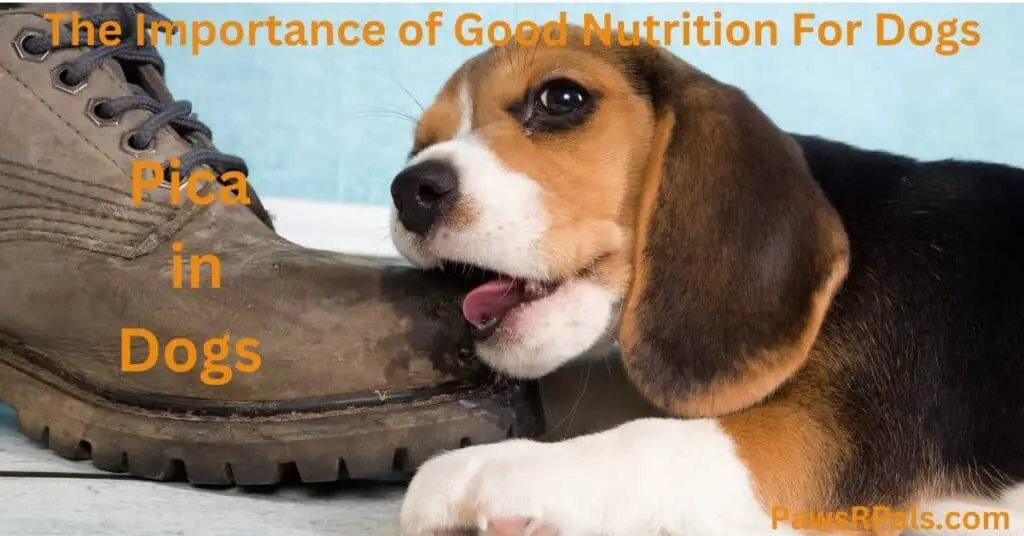
Excessive grass eating can also be classed as pica or problems with the digestive system – eating grass is a normal dog behavior, so it needs to be observed if this is excessive or expected behavior.
It is also possible that the dog is eating non-food items as a way to engage attention (if this is the case, some behavior modification can be done carefully to redirect the dog to better habits for gaining attention) – the first step is to observe if the cause is physical or psychological.
The dog may have a medical condition, lack of nutrients, or parasites causing the pica – a complete check-up and blood work carried out by a veterinarian will highlight any issues.
Obesity in Dogs
In Western society, obesity affects humans and our pets, including dogs. As little as 15% above a dog’s ideal body weight is enough to cause severe issues to a dog’s health, such as:
- inability to regulate body temperature and cope with warm weather
- heart problems (hypotension as the heart has to work harder and tachycardia a rapid heart rate acerbated by extra weight)
- breathing problems
- decreased immune function
- skin and coat issues
- reproductive issues
- liver problems
- diabetes
- joint problems
- digestive issues
- increased risk of complications during anesthesia (the anesthetic goes into the body’s fat – obese dogs will have more fat and will take longer to recover)
- low stamina
- overall shorter life expectancy
An obese dog may suffer from one or more of these conditions, as well as being lethargic and having little interest in going for walks or playing – this can also result in the dog becoming depressed. Add to this the additional strain on muscles and joints (possible pain in the joints), and the dog may struggle to move and get around, making it further reluctant to engage in training or playing.
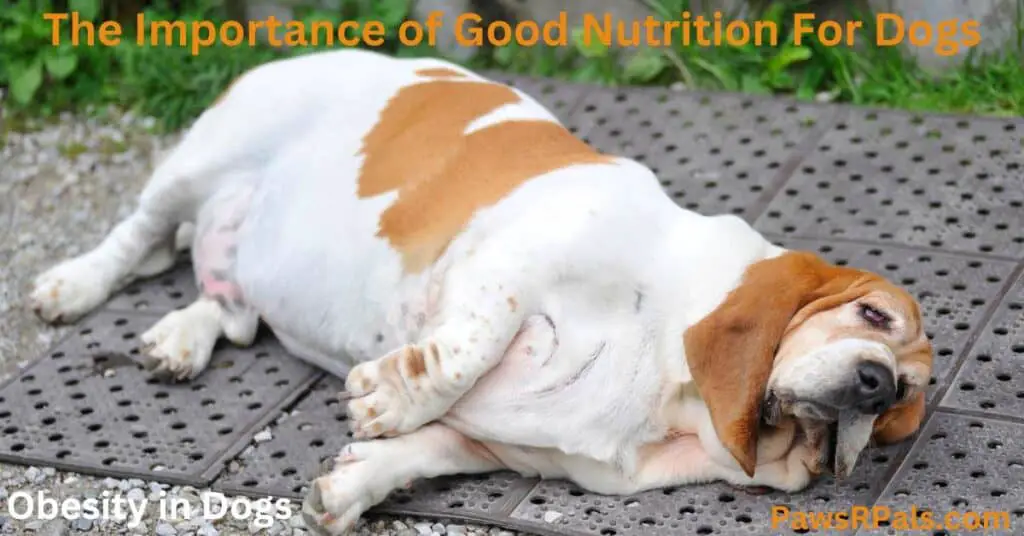
This may help a dog fit into a sedate/low-energy home; however, it is a pretty miserable life for a dog whose natural state is to be attentive, playful, curious, and happy.
The quality of food that a dog ingests will affect not only its body but also its behavior – a food with lots of chemicals and coloring additives can cause a hyperactive and crash effect on our dogs – much like humans having a sugar rush and then a crash.
Their bodies are flooded with energy, and their minds go hyper-alert; they don’t know how to deal with the excess stimulus, and then they crash, leaving them in low mood/depression – having the same food every day evoking the same response every day will have a long-term negative impact on their behavior and mindset.
Often, changing to a better quality dog food can have an almost instant positive effect on the dog’s behavior as it is not experiencing the dramatic highs and lows of the food additives (one of the first questions a behaviourist will ask is what they eat).
A Dog’s Diet Should Contain:
Protein
Protein is vital to maintaining a dog’s health; it aids in repairing muscle, skin cell renewal, hormone, and enzyme creation, and hair growth – a healthy dog requires 22 different types of amino acids, some of which will come from their diet, the dog’s body also creates amino acids. Puppies, dogs with an active life, and working dogs require a high-protein diet; dogs that aren’t overly active require less protein.
Too much protein is flushed out via urine; however, too much protein over an extended period and insufficient activity will cause the dog to gain weight. A diet of 20-30% protein is usually adequate for an average healthy adult dog – active dogs (working dogs), puppies, and old dogs will need more protein.
Protein is found in
- Meat
- Fish
- Eggs
- Grains
- Legumes
Carbohydrates
Simple carbohydrates (often found in cheaper commercial dog food as a bulking agent) don’t offer much nutrition.
Foods that contain complex carbohydrates:-
- Vegetables
- brown rice,
- sweet potatoes
- oats
These carbohydrates contain collagen fiber, enzymes, vitamins, and minerals, giving the dog slow-release energy and nutritional value.
Fat
Properly balanced fats from good sources benefit the dog’s brain, heart, eyes, and muscle function. Sardines offer EPA (Eicosapentaenoic Acid – anti-inflammatory fatty acid) and DHA (Docosahexaenoic Acid – brain and eye health). Alternating different types of meat and/or fish allows a variety of fatty acids into the dog’s diet.
Minerals
Although minerals are created in the dog’s body, it also needs minerals from its diet. Minerals often work alongside vitamins and enzymes to keep the body running healthily. Minerals help the formation of bone and cartilage, manufacture hormones, muscle and nerve function, and transport oxygen around the body through the blood.
Macro minerals are needed in a higher quantity in the diet and stay in the body easily. Micro minerals are required in smaller amounts but are just as important as macro minerals.
Calcium
Calcium is needed for bone formation, muscle contraction, coagulation of the blood, and transmitting nerve impulses. However, too much calcium in the diet can cause serious bowel problems.
Calcium is found in bones, leguminous plants, and dairy products (dogs are long-term dairy intolerant). Commercial dog food contains enough calcium. Too much calcium in a pup/young dog’s diet can cause joint problems, such as hip dysplasia.
Phosphorous
Large amounts of phosphorous are required for a dog to maintain strong bones, strengthen cell walls in their body, and store and transfer energy. However, excess phosphorous can cause issues such as renal failure. Phosphorous and calcium should be at a ratio of 2/3 calcium to 1/3 phosphorous. Phosphorous is high in meat and organ meats.
Magnesium
Magnesium aids the body in absorbing other vitamins and minerals, such as vitamins C and E, calcium, and phosphorous (too much calcium and phosphorous can disrupt magnesium absorption).
Magnesium is found in:-
- Fish
- Soybeans
- Wheat germ
- Whole grains
- Milk (dogs are long-term dairy intolerant)
Potassium
Potassium is in the cells and is required for enzyme, muscle and nerve function, and fluid balance in the body. Potassium is found in unprocessed meats, leafy green veg, and some fruits such as bananas.
Salt or sodium
Salt helps regulate osmosis (water passing in and out of the cells in the body – distributing nutrients throughout the body, and helping eliminate waste from the body) and other cell functions.
Commercial dog food uses a similar ratio as typical prey animals. Prolonged vomiting and/or diarrhea can cause a salt deficiency and require a vet consultation and possible treatment.
Copper
Copper helps in bone, collagen, and connective tissue, absorbing iron and mature red blood cells. It is an antioxidant and develops the pigment in the dog’s coat. Copper is in liver, fish, whole grains, and legumes. A copper deficiency can cause anemia and abnormal bone development.
Iodine
Iodine is necessary for thyroid function – thyroid hormones control the metabolism, and thyroid dysfunction significantly impacts a dog’s health and behavior. Iodine is found in fish and sea salt; sea kelp can be used as a supplement. Commercial dog food usually has potassium iodide/sodium iodide/calcium iodate as a supplement.
Iron
Iron works alongside copper and protein to produce hemoglobin – which transports oxygen around the red blood cells.
Iron can be found in:-
- Liver
- lean meat
- Fish
- Whole grains
- Legumes
A constant supply of iron must be absorbed from the small intestine, as red blood cells only survive for approximately 110 days and then must be replaced. An iron deficiency can cause anemia.
Manganese
Manganese provides the correct utilization of protein and carbs by the body and produces the enzymes that produce energy and fatty acids.
Manganese is found in:-
- Whole grains
- Seeds
- Nuts
- Eggs
- Green vegetables
Selenium
Selenium has antioxidant properties and works with vitamin E and certain other enzymes to protect cells. Selenium is found in high-protein plants like cereals. Selenium can be toxic in >0.9mg/lb of food over an extended time, which may result in hair loss, anemia, cirrhosis of the liver, or lameness.
Zinc
Zinc has antioxidant properties and aids in metabolism (hormone production from cortisol to thyroid hormone), DNA and RNA replication, brain function (memory and learning), maintaining eyesight, and strong hair. Zinc is found in fresh meat. Northern breeds, such as the Husky and Malamute, are prone to zinc deficiency as they have difficulty absorbing zinc.
Electrolyte
Electrolytes are electrically charged elements or compounds that dissociate into ions when water dissolves and can conduct electricity. Electrolytes are responsible for cell communication. Sodium, chloride, potassium, calcium, and phosphorous are all electrolytes.
Enzymes
Enzymes are protein molecules that speed up chemical reactions between the cells and work as catalysts, ensuring biological responses function correctly (usually at a low temperature). Thousands of different enzymes allow the cells in the dog’s body to communicate and function. They lower the activation energy, and every reaction has a specific enzyme for its function.
Vitamins
A good quality balanced diet should contain all the essential vitamins and minerals that a dog needs to live a long and healthy life. However, vitamins or multivitamins can benefit dogs, especially as they age or have health issues (stress and anxiety deplete Vitamin C).
Water-soluble vitamins get flushed out of the dog’s body via urine. However, fat-soluble vitamins are stored in lipocytes and need to be monitored – it is rare for vitamins to become toxic, but it should be remembered that it is possible.
Vitamins and minerals all play a part in helping the dog’s body run as it should. Like food sources, not all vitamins are created equally. Looking for good quality vitamins is more beneficial than cheaper multi-nationally produced vitamins and valid customer reviews of vitamins can be helpful.
If a dog requires vitamins, they usually are given as an injection by your vet.
For a dog to grow and develop a healthy body, it needs to have a healthy diet full of the vitamins, minerals, and nutrients it needs to fulfill its requirements. These include vitamins C, D, and K, calcium, and phosphorus.
Vitamin C is especially good at working with iron to create collagen – which helps build and maintain healthy joints and cartlidge – it is good for arthritis and reducing the impact of hip dysplasia (a puppy predisposed to hip dysplasia can improve/reduce the chances of hip dysplasia by having vitamin C supplements from birth).
Stress depletes vitamin C in the body; a stressed dog will be prone to vitamin C deficiency and the negative health issues associated with vitamin C deficiency, so vitamin C should be supplemented to compensate for this.
Essential Fatty Acids
Essential fatty acids are crucial for everyday living for a dog; they help throughout the body, from repairing cells, skin and coat condition, to keeping the heart healthy.
Omega 3 is found in:-
- fish oil
- flaxseed oil
- walnut oil
- soy
- canola.
Omega 6 is in
- poultry body fat
- egg yolks
- some fish oil
- corn
- soy
- canola
- safflower oil
- sunflower oil
- whole grains.
Plant-based enzymes can be added to a dog’s diet – especially older dogs who may struggle with digestion – as they assist in getting more nutrients from their food. Plant-based enzymes can also help dogs who still seem hungry after eating.
Commercial Dog Food
Much like the human diet, the dog’s diet has developed and is a vast commercial endeavor (especially in the Western world) done mainly for profit, with nutritional requirements not being met.
Not all commercial dog food is nutritious and good for our dogs – the law in the United Kingdom (Food Standards Agency) says that manufacturers must list the ingredients (done in categories and percentages – it doesn’t have to be specific).
Labeling can also draw attention to, or the absence of, particular substances, which must not be misleading; however, manufacturers have developed shady/hazy wording for ingredient lists to baffle people into thinking they are buying nutritional food for their pets.
Poor quality food causes poor health and behavioral problems for dogs.
Animal meat is usually from parts of the animal that are surplus to human consumption or not usually consumed by humans. The animals must be inspected before slaughter and deemed fit for human consumption.
They need to be free from disease and not from disabled animals. Any meat products from these are classified as animal by-products. These checks come under the EC Regulations, and Defra is responsible for them. The responsibility for enforcing these regulations falls to the local authority trading standards.
How Commercial Dog Food is Made
Dog food is cooked in large vats at high temperatures (220 – 270 degrees F), called rendering. This process enables the meat to be utilized, as it would typically be considered useless. The fat is skimmed regularly from the cooking meat and used later – often sprayed onto kibble to make it more appealing.
After rendering, vitamins and other additives are added to the food. Artificial colors and preservatives are added to make the food more appealing to humans (dogs don’t care what color their food is!) and ensure a longer shelf-life – which often involves added chemicals!
For a dog food to be labeled complete, it must include the dog’s daily allowance of vitamins. If the package says it contains 20% (for example) chicken – it must have 20% chicken.
Commercial Dog Food Terminology
Knowing manufacturers’ terminology ensures you can select the best food for your dog. In the ingredients:
Pure or fresh “beef”, “chicken”, “duck”, and “fish” means precisely that and are accompanied by the cooking method.
Derivatives (most common) means that they derive from and don’t specify what part of the animal has been used. For example, chicken derivatives can encompass bones, feet, and beaks – it isn’t specific about what part of the chicken is used in the food.
Meat Derivatives used in the ingredients don’t specify what animal source the meat is coming from, and often is a mixture of different animal sources. It also doesn’t identify what parts of the animal are used. This also makes it impossible to determine how much nutritional value is in the food.
Meal refers to bone meal, which is finely ground bone and other animal parts – a cheap and readily available bulking agent – the nutritional value is unclear; it claims to add calcium to dog food.
Hydrolyzed animal protein is a protein of an animal broken down to its smallest form, touted as hypoallergenic because it prevents the immune system from recognizing the substance and rejecting it. The animal or body part is unspecified.
Although dogs are dairy intolerant – dairy produce is added to some food and treats to make them more palatable.
Sugar beet is often included as a fiber; the sugar is usually removed; however, there is debate about whether this is suitable for dogs.
Fat is necessary in a dog’s diet; however, spraying fat from unspecified animal sources is a questionable practice to make it more appealing to dogs rather than a nutritional additive.
Vegetable derivatives are included in the same way that meat derivatives are. If it is pure vegetables, they will be listed and are better for your dog than derivatives.
Until recently, many dog foods relied heavily on wheat and grain as a filler – it is cheap and fills the dog up. However, the adverse effects of grains in dog foods have made many manufacturers use Rice instead, which is deemed safer for dogs.
Botanicals or Plants, which include herbs added to the dog food, are usually found in higher-priced dog foods and are included as a health enhancement.
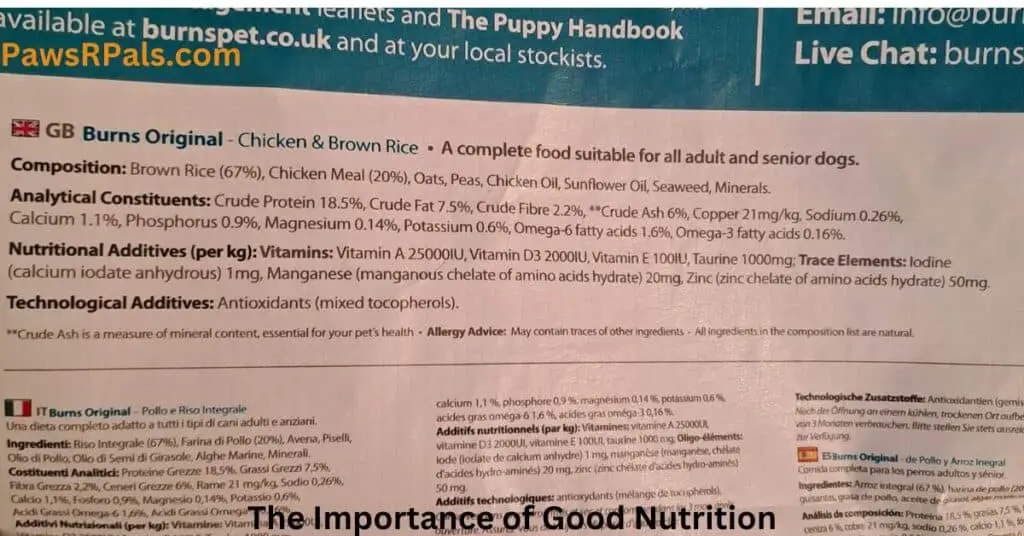
This is what Luna has been on for the past couple of years.
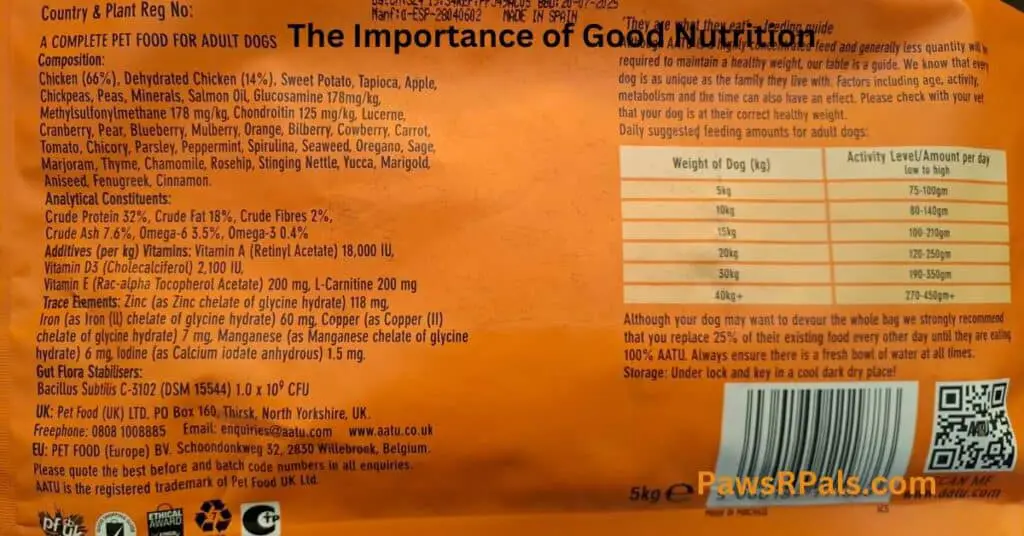
This is what she is transitioning to now, the Aatuu 80/20, as it gives more detail of what is included, and doesn’t use derivatives or meal.
Dieting for Overweight Dogs
To help an overweight/obese dog lose weight, food quality, nutritional supplements, and a careful exercise schedule should all be considered. Cutting down the food and increasing the exercise might cause more harm than good – the heart may not be able to withstand a sudden increase in activity/pressure.
Reducing the food is a good starting point; however, adding some supplements to aid the body’s immune system and recovery will help; it may also be necessary to delay additional exercise until the dog has lost some weight.
Using a slow feeder can help slow a dog’s eating and make it more interesting – adding steamed vegetables will bulk out meals if the bowl looks too empty, and add some extra vitamins and minerals.
Be aware of treats and snacks – switch to veg or fruit rather than processed treats/snacks. A one-day fast can often aid a dog in losing weight, as it allows the digestive system to rest and recover – dog in the wild usually have a fast day with no adverse effects – Siberian Huskies are also known to have a fast day or so, they won’t eat of their own accord, and it is nothing to be concerned about.
It may be necessary to go very slowly with an obese dog when reintroducing exercise to its life – starting with 5 minutes a day and gradually increasing when the dog can. Obese dogs cannot regulate their body temperature, so you must be careful not to overheat them/heat exhaustion.
If they start overheating, gradually reduce their body temperature using wet towels (never put a hot dog in cold water, as this can cause them to go into shock).
A common condition in dogs now is diabetes – type one is when a dog is born with the inability to create/maintain its insulin properly and type two, which is diet related (too much sugary/high fat/processed food), is when the pancreas is unable to create enough insulin for the body to deal with the excess sugar.
If you add a poor diet and extra weight, the dog will need additional medication to help its body cope. Obesity and diabetes can be fatal.
Dogs Need Fresh Water
Dogs always need access to clean, fresh water – a dog can only survive a few days without access to water but can go longer without food. A dog drinks approximately ten times daily, more if it eats dry kibble, is nursing, or is sick. A drop in as little as 10% of its daily intake can cause a dog to become seriously unwell.
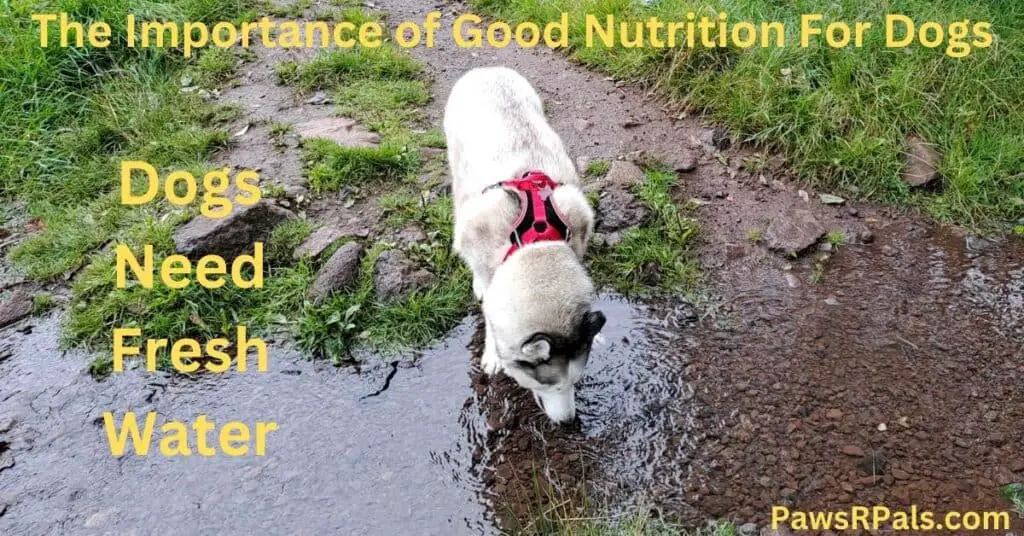
Final Words
I had no idea how much a diet impacted a dog’s life until I started researching for my Canine Nutrition Diploma. It has made me re-look at my dog’s commercial dog food and switch to better quality dry food. Luna is getting older now and has been showing signs of stiffness in her legs after being laid down, so I want to ensure she’s getting all the nutrition she needs.
Financially, especially in today’s climate, cost is a big issue. It is often a case of looking at the ingredients and choosing the one with the least amount of additives – balanced against vet costs, and it may pay off in the long term!
Thank you for reading, and good luck on your pet nutrition journey.
You can find more information about Dr Jean Dodd’s here.

Leave a Reply